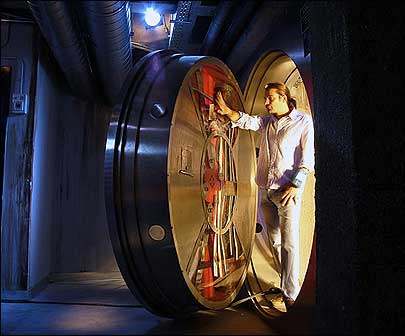You might be surprised to hear that radio frequency identification has a fun side, especially when it involves tracking your every movement. Even so, a number of adventure-seekers are strapping RFID tags and PDAs onto their wrists in order to take part in a new interactive game. The goal: to escape from Mazzinia, a futuristic high-security jail.
Named La Fuga (The Breakout), the game opened this month at a former bank not far from the Real Madrid Stadium in northern Madrid. The facility can host up to 300 players at a time, each of whom tries to solve quizzes and pass through different obstacles in order to escape.
Every player receives a console consisting of a specially designed PDA worn on the wrist. Between the PDA and its wrist strap is a passive RFID tag with a unique ID number used to locate and identify each player during the game.
“RFID provided an easy way to identify every player individually,” says Josep Cabestany at Négone, a Madrid-based developer of interactive games. The company invested €16.3 million to design and produce the technology on which La Fuga is based, and to convert the bank into the equivalent of a three-dimensional game board.
The PDA communicates to the game system by means of wireless technology developed by Négone. A player uses the console to answer the questions, and to receive information such as score, battery level or time left.
“The game system activates the quizzes, the doors and the tricks in response to the detection of the tags. This allows the system to keep track of the gaming information of each player and generate each player’s game individually,” Cabestany says.
RFID interrogators (readers) placed in doorways and in other areas of the game rooms enable the application to detect a player’s location, and to use that information to drive the gamer’s experience. For example, when the interrogator detects a person in a certain location, the system might display questions on the PDA screen that he or she must answer in order to progress. On the other hand, it might signal doors to open. “There can be more than 10 readers per room, totaling about 200 in the whole center,” says Cabestany.
Négone says it developed both the PDAs and the RFID interrogators. For the tags, however, the company turned to Swiss RFID transponder specialist Sokymat, which also helped Négone determine how to embed the tags in the wristband.
The system uses Sokymat’s passive 125 kHz Clear Disc tags. In selecting the tags to be used, Négone considered the technical, financial and practical requirements of its system. “We didn’t need a fast data transfer, or to perform write operations, but as the tags were going to be embedded in plastic and close to the player’s body, using low frequency was the best solution,” says Cabestany. While the performance of all RF signals can be adversely affected by metal or water, low frequencies are better able to penetrate people’s bodies and other objects with high water content. Therefore, 125 kHz tags were deemed best suited to this application.
In addition, because Négone needed to deploy a large number of interrogators in its gaming center, it wanted to reduce the potential of interference from other game players’ tags. The 125 kHz system offered a read range of about 1 foot, which well suited the company’s requirements. However, the application did require a larger than usual antenna to get the required read performance. Sokymat’s Clear Disc tags come in standard diameters of 20 millimeters and 30 millimeters, but this application uses a specially produced version with a 50-millimeter antenna.
After trying several different tags, Négone says it selected Sokymat’s for its better performance and quality. The company also says it is planning to opening similar game centers in the United States.


